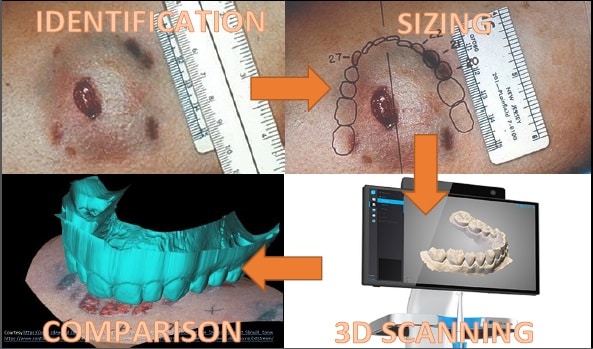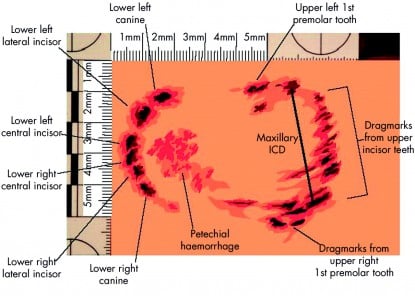In the realm of science, forensic dentistry is fast expanding its space. Forensic odontology is a specialized field of dentistry that analyses dental evidence in the interest of justice. It has been established as an indispensable science in medico-legal matters and identifying the mutilated, unknown dead person. Various methods have been developed to determine age, sex, race, and ethnicity of the person using dental tissues. Forensic dentistry proves to be a significant ray of hope where the conventional means of identification goes in vain. The objective of this presentation is to highlight the role of dentistry in the field of forensic odontology, such as bite marks and DNA profiling.
INTRODUCTION
Forensic Odontology is the branch of dentistry that deals with the proper professional handling, examination, interpretation, and presentation of dental evidence in criminal and civil legal procedures.
The evidence that may be derived from teeth is the age, identification, and bite marks that are left on either the victim(by the attacker), the perpetrator(by the victim), or on an object found at the crime scenes.
IDENTIFICATION BY DENTAL DNA PROFILING
Dental DNA is an excellent source for identifying mutilated human remains at the mass disaster level. The unique composition and location of teeth in the jawbone provide additional protection to DNA as compared to bone and their resilient nature and preservation for a longer time.
Dental DNA is taken from dentin, pulp, and cementum of Molar (mostly) and Canine.

IDENTIFICATION BY USING BITE MARKS
Bite marks are considered to be an expression of dominance, rage, and animalistic behavior. Bite marks are the commonest form of dental evidence presented in criminal court in rape cases. These marks are also valuable in determining the type of physical abuse and age bracket of the criminal.
A bite mark is known as the registration of the cutting edges of teeth on a substance caused by a jaw closing. Bite marks are either left on the victim (by the attacker), by the perpetrator, or on an inanimate object found at the crime scene.
Q. What is the first step in identifying a bite mark?
The dentist first analyzes the bite to identify it as human. Animal teeth are very different from human teeth, leaving very different bite-mark patterns. When an investigator sees something on a victim that even resembles a bite, a forensic dentist is called in immediately because time can affect bite marks. For example, if the victim dies, the skin may slip as the body decays, causing the bite to move.
Specifications About Bite Marks
Analysis of bite marks plays an important role in personal identification in forensic casework. A clear impression means that there was significant pressure; an obvious bite signifies medium pressure, and a noticeable impression means that the biter used violent pressure to bite down. The movement of a person’s jaw and tongue when they bite also contributes to the type of mark left.
How are bite marks used as individual evidence?
Like fingerprints and DNA, bite marks are unique to an individual – such as distance and angles between teeth, missing teeth, fillings, and dental work. This type of impression evidence can be left on the skin of a victim and also can be in food, chewing gum, and other miscellaneous items such as pens and pencils.
What type of evidence is a bite mark?
Bite marks are used in criminal investigations; that’s why they are investigational pieces of evidence.
Where are bite marks commonly found?
Human bite marks on victims are most often found on the skin and soft tissue areas of all body parts.
What are the three steps in analyzing bite marks?
(1) Registration of both the bite mark and the suspect’s dentition, (2) comparison of the dentition and bite mark and (3) evaluation of the points of similarity or dissimilarity.
What are the seven types of bite marks?
• Haemorrhage (a small bleeding spot),
• Abrasion (undamaging mark on the skin),
• Contusion (ruptured blood vessels, bruise),
• Laceration (near puncture of skin),
• Incision (neat punctured or torn skin),
• Avulsion (removal of skin),
• Artefact (bitten off a piece of the body).
Related Cases of Famous Personalities
- Identification of Junaid Jamshed was made from his facial X-ray and history of his teeth by Dr. Humayun, Deputy Commissioner told the Associated Press of Pakistan.
- Paul Revere performed the first documented application of forensic odontology in the United States to identify the remains of the man who sent him on a midnight ride.
- Adolf Hitler was identified after his death in 1945 based on remnants of a bridge(false teeth) in Hitler’s jaw because of the unusual form of reconstruction.
- The late president of Pakistan, General Zia-ul-Haq, who died in a plane crash in 1988, was identified by his dentition.



